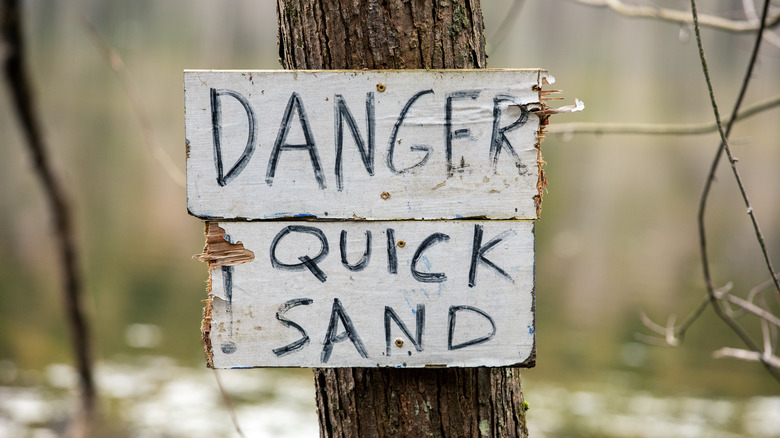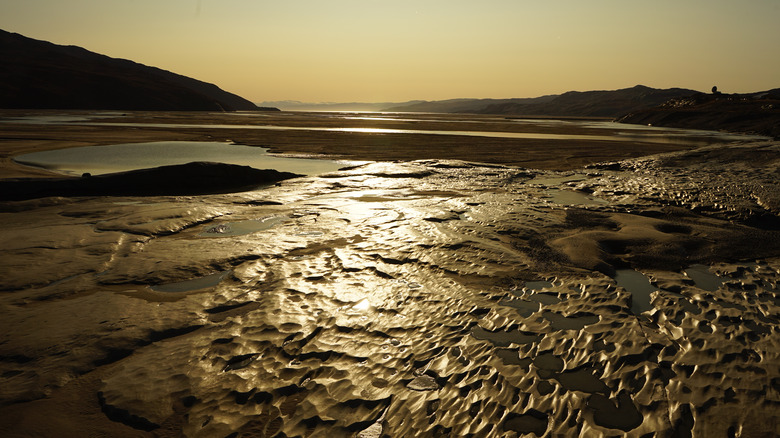What Is Quicksand And Where Does It Come From?
So here's a typical scene of cinematic peril: Two hapless folks are poking through a lethal jungle, one of them carrying a machete, and the one in front calls out to the one in back. No response. The person in front turns around, looks back, and there's a safari hat floating on a puddle of brown soup. Uh oh, grab a rope! Your buddy is sunk into the sand into which things quickly sink, aka the "quicksand."
While this makes for fine, if silly, Hollywood fare, we're kind of sorry to report that quicksand doesn't really work like that. It's not a black hole on Earth into which things forever drown. As Live Science says, it's a mixture of sand and water — that's it. If something breaks its surface tension, the mixture's molecules bounce around a bit and become loose enough — liquid-like — to cause safari-goers to plunge. As Nature cleverly describes, this is similar to the downward flow of a stack of collapsing oranges. Molecular motion creates a vacuum.
However, there's no danger of getting in over your head, so to speak. Quicksand has an overall density of two grams per milliliter, per National Geographic, while humans have a density of about one gram per milliliter. So, only half of your mass would sink (math!). Unless you're extremely, extremely bottom-heavy (or wearing iron boots), you'd stop sinking somewhere around your waist. No problem grabbing your machete-carrying buddy's rope of rescue.
Pockets of air and water
Let's dive a bit deeper into the dirt with the help of Darrel Long, sedimentologist at the Department of Earth Sciences at Laurentian University in Sudbury, Ontario. As Long describes at Scientific American, quicksand can form when individual grains of sand are ovular rather than spherical. Spherically grained sand is packed together pretty tightly, with about 25% to 30% of it being empty space. This is the kind of sand on a beach. Your foot smooshes it, and because of the space between its grains, the sand rises around your feet and between your toes. The same displacement happens when you drop an ice cube into a glass of water and the water level rises.
Quicksand, however, forms from longer grains of sand. Such grains stack in a different arrangement that leaves more empty space — from 30% to 70%. This kind of sand, like the aforementioned stack of oranges, or even a stack of cards, loses its form more easily. When vibrations, pressure, or moving water overcome the friction holding the grains together, the whole thing collapses.
And for the record, it's possible for quicksand to form in a desert, but it's very rare. In this case, the space between grains is filled with air, not water. This makes the sand very loosely compacted. If something disturbs the sand, like wind, its grains can slip into a more densely compacted shape. Usually, though, this kind of quicksand only sinks a few centimeters.
Mountains to rivers, rivers to seas
Quicksand doesn't occur everywhere. Contrary to the movie scene we described earlier, quicksand can't just crop up in any random patch of jungle or forest. As Scientific American says, quicksand usually occurs in alluvial fans: watery junctions between mountains and the gravelly bits at their base. Water flows down mountains, transitions to rivers, and in between passes through some cone-shaped swath of sandy, muddy earth (pictured above). Quicksand forms easily in these regions because of water coming back up once it's plummeted down from the mountain. Another place where quicksand forms easily, as the BBC says, is river deltas, where rivers branch out into larger bodies of water. Besides these, quicksand can also form in swamps and marshes, via Mental Floss.
While the word "quicksand" contains the word "sand," and we've been referring to quicksand being composed of sand, quicksand can also form from any kind of dirt, granular soil, sediment, salt, scree, and the like. It just depends on the shape of the grains and the overall shape of the latticework of grains. If it's too fragile, then its apparently solid surface is just an illusion, and it's not solid through and through. Strictly speaking, if enough of a sand-water mixture is water, then it's a "suspension," whereby the solid matter is floating, or held aloft, by its own water-filled spaces.


